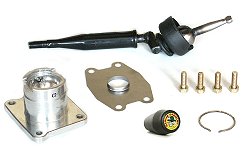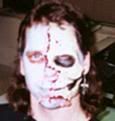Post by DeadlyPeace on Feb 9, 2008 13:01:31 GMT -5
Q: Body lifts puts too much stress on the frame. Is this true?
A: No, a 2" or 3" body lift is very common and is not a problem with stress to the frame.
WHY A BODY LIFT:
Body lifts of one or two inches are often necessary to keep big tires (fat tires as well as tall ones) from rubbing the fenderwells. Suspension lift alone—no matter how tall--will not keep tires from rubbing.
Here’s why: When the axle reaches full up-travel and hits the stock bumpstop, tire-to-fenderwell clearance is the same if not less than on a stock truck. It could be less because the more the axle droops on one side, the higher the tire goes into the fenderwell on the stuffed side—because the axle pivots on the bumpstop.
As far as tire-to-fenderwell clearance is concerned, suspension lift height means nothing when the axle hits the bumpstops. You’re left with stock clearance or less. And if your tires are 35 inches or larger, they’ll rub on just about anything but a street-only or a well designed trailer queen. To cure the rub, you either have to lower the bumpstops (which limits articulation) or raise the body.
WHAT IT TAKES TO ADD A BODY LIFT:
A body lift isn't that bad to put in, but can take some time to do if you're working by yourself. Most body lifts come with everything you will need. Other then lifting the body itself you may need to extend the steer bar (under the hood) and lower the radiator so it stays in its natural place with the engine. You could lift it with the body, but you'll need to get new hoses so they don't kink. You'll also need to disconnet the brake hard lines from the firewall. The line can just be stretched out a little and will be fine. For lifting the body just undo one side at a time and loosen the other. Lift the one side up far enough for the new spacers to fit in place and put the bolts in. Don't tighten them down. Lift the other side and do the same thing. After all the bolts are in and everything is sitting in place then thighten everything down. The radiator you could actully leave attached and move it down afterwards or disconnect it and let it rest against the body while lifting it.
For a 1" body lift:
You shouldn't have to deal with anything, but the lift kit itself.
For a 2" or 3" body lift:
1) The radiator mounts, to leave radiator in stock position
2) The brake hard lines on the firewall (just uncoil them a bit)
3) Lengthen the steering shaft
4) Engine ground strap (to the firewall)
5) Reposition the fuel filler neck.
6) If it's an automatic then you'll need to lengthen the shift linkage
For a 4" or taller body lift:
You'll have to make it yourself and really be stupid to want to do.
On a manual you don't have to do anything, but you can get a Short Throw Shifter.
Good for vehicles with a BL of 3" or greater to reduce the throw of the shifter by 40%. This should also help with some shifter boots getting ripped form the shifter being lower and the upper half of the shifter stretching the boot more then it should. Also good for placing shifter in tight areas where little space is available for the shifter to move.
IMHO I think.......
For a DD or DD/trail rig a BL isn't that bad as long as you don't mind the frame showing and you are aware of your COG. If your rig does see the trails then I would try to get most of your lift and tire clearance out of a SL first. Maybe a 1" BL for just some extra tire clearance would be ok as long as you don't have plans on doing a SL.
For a trail rig only, especially a rock crawler, I would do my best to leave a BL completely out of the equation.
I'm sure there many be some other pros and cons and opinions, so feel free to express them.
A: No, a 2" or 3" body lift is very common and is not a problem with stress to the frame.
WHY A BODY LIFT:
Body lifts of one or two inches are often necessary to keep big tires (fat tires as well as tall ones) from rubbing the fenderwells. Suspension lift alone—no matter how tall--will not keep tires from rubbing.
Here’s why: When the axle reaches full up-travel and hits the stock bumpstop, tire-to-fenderwell clearance is the same if not less than on a stock truck. It could be less because the more the axle droops on one side, the higher the tire goes into the fenderwell on the stuffed side—because the axle pivots on the bumpstop.
As far as tire-to-fenderwell clearance is concerned, suspension lift height means nothing when the axle hits the bumpstops. You’re left with stock clearance or less. And if your tires are 35 inches or larger, they’ll rub on just about anything but a street-only or a well designed trailer queen. To cure the rub, you either have to lower the bumpstops (which limits articulation) or raise the body.
WHAT IT TAKES TO ADD A BODY LIFT:
A body lift isn't that bad to put in, but can take some time to do if you're working by yourself. Most body lifts come with everything you will need. Other then lifting the body itself you may need to extend the steer bar (under the hood) and lower the radiator so it stays in its natural place with the engine. You could lift it with the body, but you'll need to get new hoses so they don't kink. You'll also need to disconnet the brake hard lines from the firewall. The line can just be stretched out a little and will be fine. For lifting the body just undo one side at a time and loosen the other. Lift the one side up far enough for the new spacers to fit in place and put the bolts in. Don't tighten them down. Lift the other side and do the same thing. After all the bolts are in and everything is sitting in place then thighten everything down. The radiator you could actully leave attached and move it down afterwards or disconnect it and let it rest against the body while lifting it.
For a 1" body lift:
You shouldn't have to deal with anything, but the lift kit itself.
For a 2" or 3" body lift:
1) The radiator mounts, to leave radiator in stock position
2) The brake hard lines on the firewall (just uncoil them a bit)
3) Lengthen the steering shaft
4) Engine ground strap (to the firewall)
5) Reposition the fuel filler neck.
6) If it's an automatic then you'll need to lengthen the shift linkage
For a 4" or taller body lift:
You'll have to make it yourself and really be stupid to want to do.
On a manual you don't have to do anything, but you can get a Short Throw Shifter.
 | Pic shown with Short Throw Shifter Kit w/ a Dog Leg modifcation on it |
Good for vehicles with a BL of 3" or greater to reduce the throw of the shifter by 40%. This should also help with some shifter boots getting ripped form the shifter being lower and the upper half of the shifter stretching the boot more then it should. Also good for placing shifter in tight areas where little space is available for the shifter to move.
IMHO I think.......

For a DD or DD/trail rig a BL isn't that bad as long as you don't mind the frame showing and you are aware of your COG. If your rig does see the trails then I would try to get most of your lift and tire clearance out of a SL first. Maybe a 1" BL for just some extra tire clearance would be ok as long as you don't have plans on doing a SL.
For a trail rig only, especially a rock crawler, I would do my best to leave a BL completely out of the equation.
I'm sure there many be some other pros and cons and opinions, so feel free to express them.




 [/glow]
[/glow]